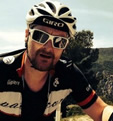Mont Ventoux is undoubtedly one of the toughest climbs in all of France. It is iconic in Tour history and has seen many a decisive battle for its hand. Mont Ventoux entered the Tour in 1951 when Frenchman Lucien Lazaridès led the race over the top and immortalised it in cycling folklore.
To win on Ventoux is the stuff of legends. Interestingly, Lance Armstrong failed to win on Ventoux in his jaded career. I like to think this was the mountain taking something back for the pure and good of the sport. The French philosopher Roland Barthes said of the 'Sleeping Giant', "The Ventoux is a goddess of Evil, to which sacrifices must be made. It never forgives weakness and extracts an unfair tribute of suffering."
Still, it's only a big hill. I mean, how hard could it be...?
In that spirit I signed up for the Gran Fondo Mont Ventoux, a 170km sportive with 3500m of climbing, including an ascent of the fabled Ventoux itself. I entered as part of a group of five hardened roadies. Three had gone ahead by car with bikes and kit, leaving two of us to get a flight from Gatwick to Marseille.
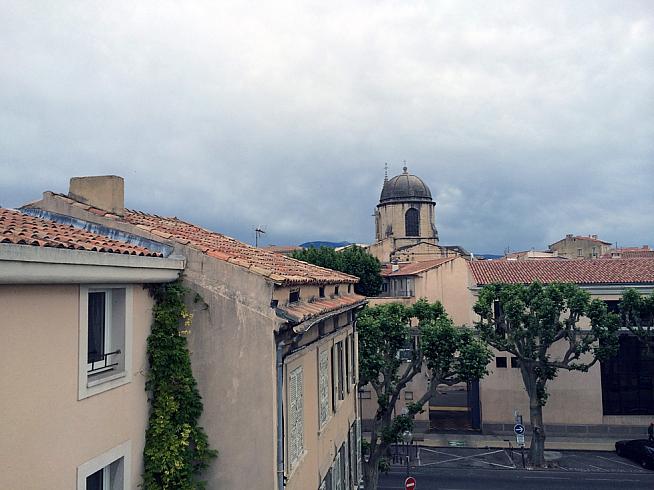
We spent our first night in France at the Hotel du Forum, Carpentras. It was run by an extremely helpful and friendly chap called Herve who allowed us to store our bikes locked safely away in the hotel basement. Once we had unpacked, laid out kit and double checked headsets, chains and rear mechs we sauntered out into the warm dusky evening to find a local pizza/pasta emporium and to complete our regimented carb loading plan. There were many other cyclists staying at the Hotel du Forum; Herve and his staff were very accommodating and attentive to all our needs. In the morning, 'le petit dejeuner' was excellent with enough variety to fill every stomach no matter how bad the nerves were.
Carpentras is perfectly situated for the Gran Fondo Mont Ventoux as it is only 10km from Beaumes de Venise, and also it is downhill all the way. It was the perfect warm up to start the day. We span out our legs, chatted nonsense and pedalled steadily to the start line. Along the way our first glimpse of Mont Ventoux was revealed; to our right and far off in the distance she sat sleepily amongst the early morning haze, the white limestone summit kidding us that snow was still present. It was a sobering sight and the true enormity of the task ahead dawned on us all.
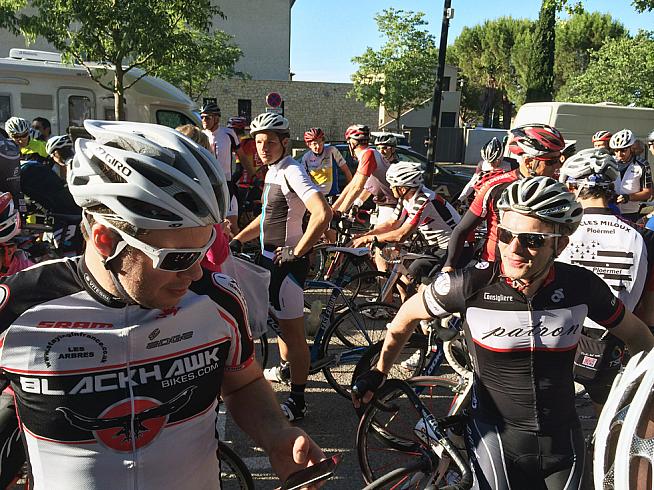
On arriving in Beaumes de Venise we snaked through the narrow streets and found our way to the start line. Although it was early the sun was beating down and the temperature was increasing, which was a concern and an indicator of what was to come. There was a small stall selling all manner of cycling gear, both new and second hand. Cloth caps were admired, gels and emergency energy bars were purchased and stuffed into back pockets.
We positioned ourselves in the group second from the front but soon the sheer number of participants blurred any specific classification. Just after 8:30am a suitably nonchalant and slightly late French car horn indicated that the race was on. We filed steadily over the timing mat and under the inflatable start/finish arch.
We were off, and we were off at a rather alarmingly rapid pace. Looking down at my Garmin indicated that we were cruising along at a steady 25 mph, peaking at 29mph. Steady on chaps, this isn't the initial move-forming break in the Tour - or was it?! Had we inadvertently signed on to some one day Pro-Continental French Classic? The initial mass peleton had now fragmented into smaller groups and we jumped from group to group trying to find one at our pace. Making our way through Caromb and Modene we saw our first crash of the day; a sharp left hand turn coupled with some road furniture had brought down three riders. They looked uninjured and were slowly getting back onto their bikes; this however served as a reminder for us to keep our wits about us, as there were around 3000 riders on the road.
Reaching Bedoin we turned right and after a short downhill we began to start climbing to the lower slopes of Ventoux. Mont Ventoux tops out at 1912m with an elevation gain of 1639m. Its average gradient is 7.6% maxing out at 12%, and it is 21.4km long. The start was pleasant enough, I was still able to ride along in my big ring, take in the scenery of small vineyards and chic houses and chat excitedly to fellow riders. Looking up to the left you could make out the weather station which tops the mountain. It was worryingly still a good way away.
After the St. Esteve bend the serious climbing begins, the tree line closes in and the gradient increases: this is the business end of Ventoux. For the next 10km the gradient does not drop below 9%, with a leg-destroying 2km section above 10%. This was seriously tough. Nothing I had done in my training or preparation in the North East of England could have possibly prepared me for this. Pro riders in the Tour complete the climb in around an hour with the likes of Froome and Contador dancing up in less than that. For (relatively) fat lads like me, I was hoping to complete in just under 2 hours....2 hours of solid climbing! I sometimes do shorter flat training rides, and that includes a cafe stop!
The thing I learned early on was to just settle in and ride my own pace. Another early lesson was not to look at my Garmin. It is particularly soul-destroying to feel like you have been riding for a decent amount of time and distance only to check to find that not only has the distance failed to significantly increase, but the speed would almost be quicker walking. Not only that, but you also have another hour to climb before you reach the summit.
I ploughed on. Two things began to happen: the first was I was getting passed regularly by riders who were spinning and twiddling their legs like an egg beater on their compact chainsets; bloody compacts. The second was that I was starting to catch and drop a fair amount of riders and I actually felt in control. It was tortuous, painful and hot but I was in control. Focusing on your front wheel is fairly boring, so to pass the time I started looking out for the names of cyclists that had been painted on to the road from last year's Tour. Some were still visible, althogh most had faded due to elemental factors. On one bend scrawled in spray paint was the name of Pantani. Perhaps it was coincidence, or perhaps with the 10th anniversary of his sad death it was a sign. I took it as an omen that 'Il Pirata' was looking down on us, guiding us up the climb: "No gifts". Eventually, after what seemed like an eternity, the trees began to thin out and the air became cooler. The brilliant white limestone rocks which had been initially sparse were increasing in number along the roadside; we had reached Chalet Reynard.
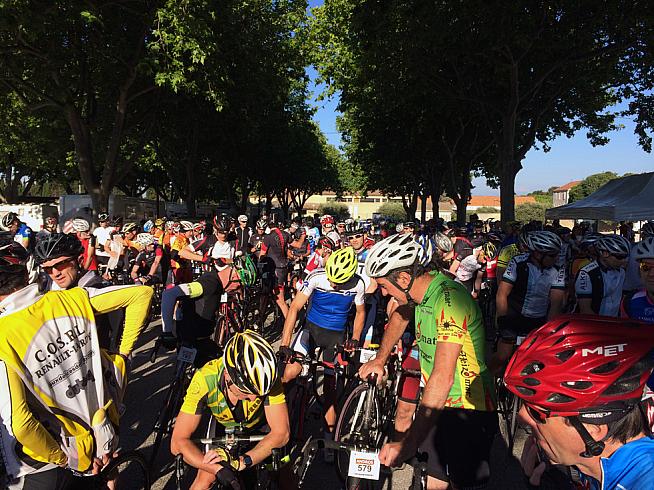
At Chalet Reynard was situated our first food stop. We parked our bikes on the floor and hobbled over the the Powerbar tent to peruse the delights it had to offer. Bananas, little french pastries and jelly sweets. Perfect. We ate our fill, refuelled our bidons and after a quick comfort break continued up the mountain. I have to say that the last 2km through the rocky moonscape was amazing and I felt fantastic. I took in the landscape all around me which I had previously only seen on Eurosport with Sean Kelly and Duffers commentating; but this time I was riding it. The thought of so many past legends riding this exact road was truly awe-inspiring.
What was also awe-inspiring was on every bend the French chaps selling their wares which were mainly made up of A3 size hand-painted canvases of current and retired cycling stars: Boonen, Cancellara, Voeckler etc. What was slightly unnerving was that interspersed between these paintings were A3 size caricatures of semi clad women. As I rounded one of the bends I pondered just what they thought the particular market was for such paintings and how one would in fact carry a canvas down the mountain on a bike.
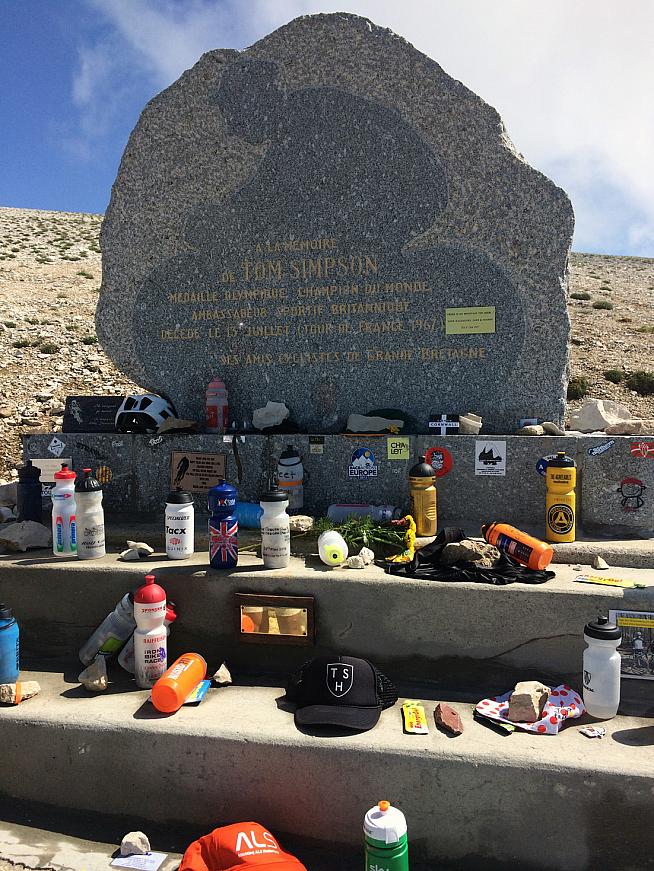
On one of the final straight sections on the right hand side stood an unassuming grey marble rock. Carved into its lface is the outline of a rider with a peaked cloth cap. It is the tribute to Tom Simpson. Simpson collapsed and died at this spot in 1967 during the vicious stage 13 of that year's Tour. A postmortem revealed traces of amphetamines in his blood and two empty tubes, one still half full were found in his jersey pocket. The infamous phrase "Put me back on my bike" is actually purported to be in incorrect, and what he actually said was, "On, on, on" before he fell unconscious, white knuckles locked to the bars. The memorial is adorned with bottles, caps, helmets and assorted stickers. It is a simple yet powerful memorial which has become a shrine for cyclists the world over. As fellow County Durhamites we paid our respects, took in the staggering view and readied ourselves for the final push. On, on, on indeed Tom.
With only a few twists and turns left the great iconic weather station loomed large. The gradient of the final bend insisted we got out of the saddle and we obliged with a token sprint for the line. We had done it: at least, the first part of it; well, to be honest not even a quarter of the ride, but the biggest ascent was behind us.
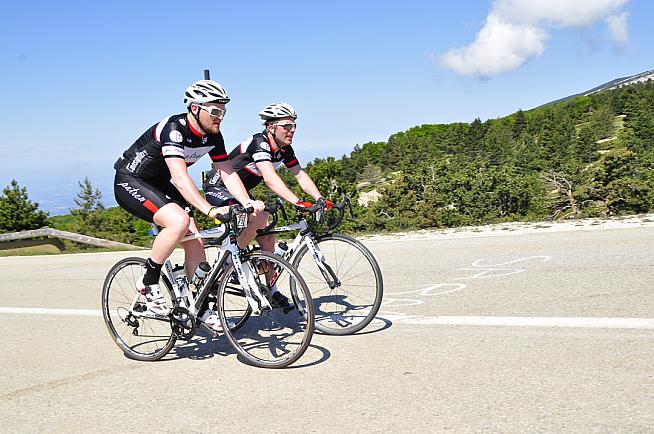
We stopped at the top to take some obligatory photos, refuel and put on any gilets or rain capes stashed on our pockets. For the record I am a hopeless descender; actually that's not quite fair. I am a complete and utter disaster zone when it comes to descending. I understand that one should use the front brake on entering the bend, spot the exit and sweep round. Unfortunately some years ago I had a bad 'offing' on a particularly wet spring road when I pulled my front brake resulting in my front wheel slipping out sideways underneath me causing a certain amount of chaffing and skin removal. Since then I have developed an irrational fear of tarmac interaction caused by front brake usage and as such I try not to use it, especially downhill.
"Soft lad", I hear you cry; perhaps, but with the vast drop offs only a few feet away, with a barrier of small metal railings the only thing between life and instant death, I wasn't taking any chances. I trundled down the hill like Andy Schleck, with my brakes locking and squealing in abject disapproval. I had a few bum-clenching moments but all in all I got down safely.
The road began to flatten out and we were back to normal riding. We dropped down into Malaucene where the next feed station awaited us. What treats were on offer at this pit stop; bananas, little french pastries and jelly sweets, I could see a pattern emerging. Eating at this stop was a little more difficult, the heat and fatigue made digesting these items less appealing and I found the pastries unpalatable.
We set off again. The road was rolling and the surface was newly laid tarmac which meant it was easy on the legs and a pleasure to ride. As we knocked up some effortless miles, stricken along the sides of the roads every now and again we passed riders that had punctured. The puncture, the vicious swine and arch nemesis of every cyclist, the one single thing guaranteed to ruin any ride and destroy morale. Oddly the number of riders by the side of the road was increasing to the point where it began to be a solid line of bikes and weary looking souls. What was happening? Was this endemic due to the road surface? The heat? Or just mere bad luck? None of the above, it turned out was the answer.
In my best 'Allo Allo' style French I turned to a nearby rider; "Pourquoi il ya tous les punctures?"
"La sellerie!" came the reply. "Celery?!" I thought. Hmmm, a quick look at the vegetation surrounding us revealed a definite lack of the crunchy salad accessory so I looked back at the rider with a face of bewilderment. "Tack, tack!" he yelled back, "Regardez la route!"
Tacks! Someone had taken offence that the roads had been closed for the Gran Fondo and had taken it upon themselves to liberally sprinkle several thousand tacks on the road, causing mayhem and as much obstruction to the race as the race had caused to them. It was the Tour all over again, the infamous 'Tack-gate' of Stage 14, 2012 on the Mur de Peguere where over 30 punctures almost caused the race to stop. The number of punctures was far higher here with many unlucky people puncturing twice, using up all their inner tubes and having to walk along the road dragging bikes behind them in stubborn defiance, heading to the next checkpoint. We sailed through, eyes glued to the road for the next few miles, looking out for shiny sharp objects. I have never been so glad to have fitted Continental Gatorskins and luckily I avoided any flats.
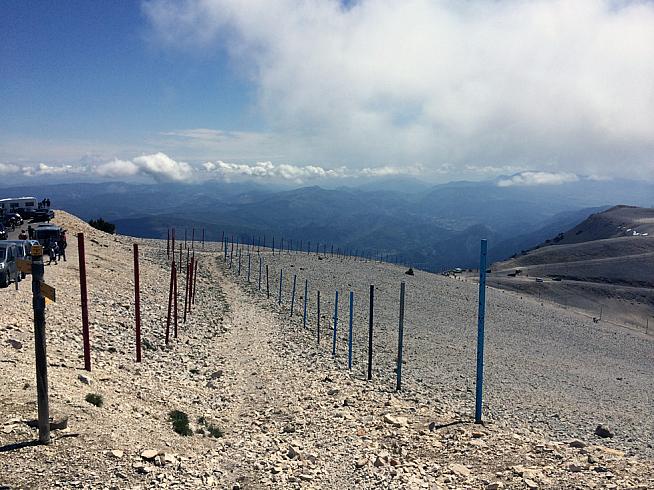
The next 30 miles passed fairly uneventfully. We grouped together with around 15 other riders with two strong Scandinavian chaps sat on the front, happy to drag the group along. The most exciting thing that happened was a man in the group who was clad in full period Peugeot kit, a la Tom Simpson, right down to the wool shorts and leather shoes. He was riding a 1960s Colnago which looked as though it had just come out of the hand built workshop. All the components had been polished to such a high degree that they had turned a white gold colour. It was a work of art and to show my utter admiration and respect I pulled alongside the rider and said, "Le vélo est magnifique."
"Merci," came the reply and that was all, the rider was a cool as his ride.
We dropped down from Aurel along the valley road. Fatigue was beginning to take a strong hold of my legs and mind. The weather had changed on this side of the mountain and clouds now filled the sky; the temperature had dropped and we were freshened by intermittent spots of rain. Our group had begun to splinter with stronger riders easing off the front and weaker riders easing off the back. Unfortunately for me I was the latter. We turned at Sault onto the second ascent of Ventoux. The winds had gotten up and with no shelter a tough cross headwind prevented any decent progress. My power was lacking and I was beginning to waver. I fell a long way back from my colleagues and tried to dig in, punching as hard as I could on the pedals through the early relentless kilometres. Behind me the clouds had turned black and the hot air had formulated a thunder storm. Flashes of lightning and sporadic crashes of thunder electrified the atmosphere and the darkened feel mirrored my mood.
I was weak and I had begun to weave on the road. I was like a crisp packet in the wind, unable to fully decide my own course of direction and relying on auto-pilot to keep my legs turning. My arms began to tingle and I could not fully grip my handlebars. "Hello old friend, it's been a while," I thought, preparing to hit the wall. With some 20km of climbing still to complete, no gels and limited water I was in trouble. A quick pat of my pockets confirmed my worst fears: I had also run out of food and was now completely alone on the climb. Brilliant.

I was getting slower. The steady 10mph I had managed to maintain on the initial climb had now reduced to 5mph then 4mph. This was when my Garmin decided to stick the knife in. I, like many of you, have my Garmin set up to 'auto pause' when stopping so I can accurately track my moving time and also to prevent me forgetting to turn it back on after a cafe stop. It was at this point, when I was at my lowest ebb, when my dignity was laid bare on the mountainside, that I heard that inimitable double bleep. I looked down to see that my Garmin had auto paused. The ruddy thing had decided that, due to the slow movement and reduced triangulation of GPS, I must have stopped!
I looked down in in disbelief, let out a little swear and carried on. After a few seconds it 'un-auto paused' with an apologetic double bleep. I was still in trouble and I thought I would double check my pockets in case I had missed a morsel of croissant. I felt a squidgy lump in the bottom of one of my pockets and pulling it out revealed a packet of nectar, energy filled sweet Haribo lizards! Chewing was an issue so I took to swallowing them whole, washing the excess sugar away with my meagre water supplies. I knew I needed to eat as much as I could to prevent further bonking. My other option was to get off my bike, go into the woods and make a survival den. I have watched many survival shows and was fairly sure I could knock up a suitable shelter, gather kindling and create a fire with a bow string. I would collect berries and wait to be rescued by a heroic burly Frenchman, probably called Charles or Pierre. I had recently watched a documentary showing the various wild animals that lived in France, these included wild boar, wolves, bears and vultures. I didn't really fancy my chances against any of these wild foe so I decided to carry on pedalling. 15km to the summit.
"Hallo?" I switched my tunnel vision from my front tyre to my left. Alongside me, a tall fit looking German chap had sneaked up on me like a velo ninja. "Are you ok?"
It must have been obvious by my colour and meandering route that I was not at home. "Non," I replied. I am still unsure as to why I replied in French to a German who could obviously speak better English than I was capable of at that point. "You will be ok, just take your time and keep the rhythm. I will ride with you for a few km."
I nodded my head in exhausted acknowledgment and mumbled "Ok." We rode together for several minutes, we did not talk but we both knew and understood what I was going through. All cyclists have 'hit the wall' and if you haven't, you haven't been riding hard enough. Eventually he wished me luck and drifted off ahead out of sight. I tried to find him at the next feed station and also at the end of the race but I did not spot him. Although in reality he said less than 20 words to me and only rode with me for 10 minutes, he massively helped me carry on and stopped me inevitably getting off the bike which would have been the worst thing ever. I am thankful to my German brother and wish him well.
Looking down at my Garmin I noticed my speed had begun to creep up, it was now bouncing between the dizzy heights of 6-7 mph. I was starting to feel less weary and I was starting to think more rationally. Either the Haribo lizards were beginning to kick in or my German guardian angel had imparted some of his energy through some kind of lycra reiki. I was back in the game.
I crawled to Chalet Reynard again and the last feed station. Food was eaten. Bottles filled. Rain jacket on. Descent. Once at the bottom I stripped off the rain jacket and bathed in the sun which had re-appeared and once again mirrored my mood. I was there; my friend told us that we would be ok now as there were no more climbs and it was an easy roll back to Beaumes de Venise. Liar. He was accurate in saying it was rolling, but had failed to identify the Col du Petit Madeleine and the Col de la Chaine. The Petit Madeleine was actually a beautiful little click and perhaps it was delirium setting in but we joked and ripped each other over the top.
All humour had evaporated by the time we hit the Chaine. We rechristened it the Col de Le Chien as it was a pure dog of a climb. With 90 miles in the legs this was the knockout punch and sting in the tail. Once we were over the top we pottered down to the finish. We crossed the line around 8 hours after we left, not an earth-shattering time but well up in the top quarter of riders. I got off the bike with a stance not unrecognisable from Albert Steptoe. On closer inspection the chamois pad in my shorts had fused itself to my behind with a combination of sweat and heat and it was obvious removal would require surgical precision...or just a really quick tear.
I had done it, conquered the mountain and completed the race. I have the utmost respect and admiration for anyone who has completed the ride, and even more for those that choose to race up it. I cannot recommend this Gran Fondo enough, and urge everyone to have it near the top of their list of rides to do.
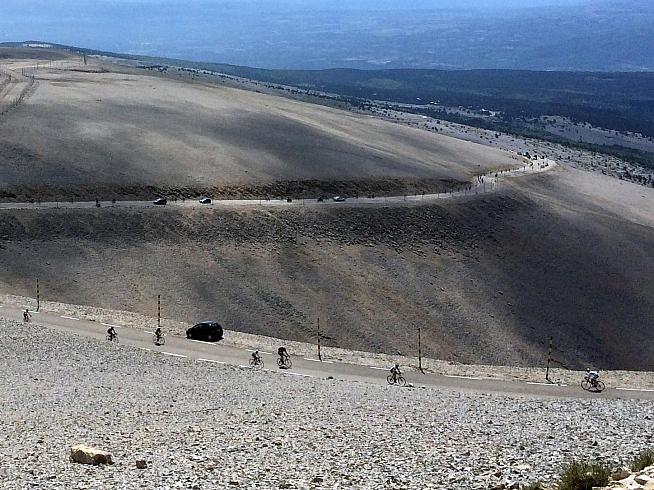
Ben's Top Tips for Riding Mont Ventoux
1) Eat early and often, as fatigue reduces the desire to refuel.
2) Stay hydrated, ideally with electrolyte or carbs based drinks.
3) Don't set off too fast and climb at your own pace.
4) Get a compact chainset - don't be a hero.
5) Ride on Gatorskin Sprints; the minimal increase in weight is worth it for the reduced risk of puncturing.
6) Be nice to your fellow competitors; karma is scientifically proven.
7) Don't stop eating.
8) Get a decent chamois cream, tender areas that have no skin are not cool.
9) Take a gilet or rain cape, no matter what the temperature at the start; descending is a cold job and the weather shifts on either side of the mountain.
10) Don't stop eating!
0 Comments

